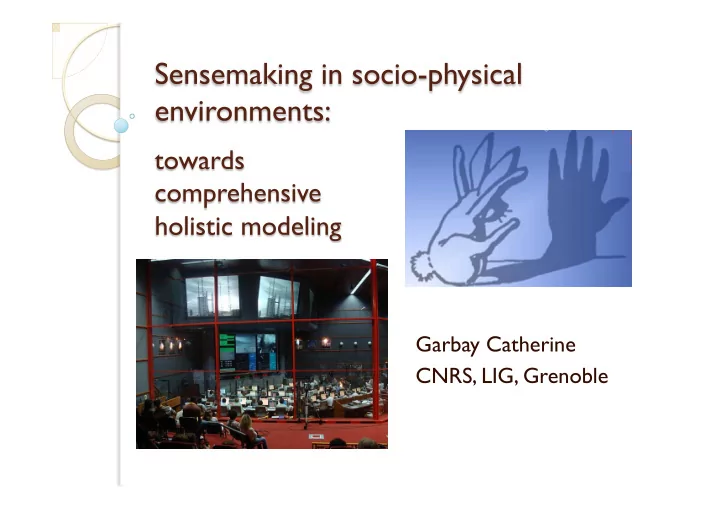

Garbay Catherine CNRS, LIG, Grenoble
Sensors capturing world-wide information in the physical, cyber or social realms Open data initiatives, Web 4.0, crowdsourcing… Multi-sensory immersion: skinput, novel generation contact lenses… Robot ensembles: multiple, inexpensive robots operating cooperatively to solve complex and dynamically changing tasks The cyber space and the physical space embedded with humans, knowledge, society and culture to form new ecosystems
From Jean-Luc Dormoy, EDF, Yellow Strom Grid-like service agencies with various embodiements that self- organize, learn and evolve their courses of action, self-improving their performances Different types of subspaces interacting with, reflecting or influencing each other directly or through the cyber, physical, social and mental spheres Versatile individuals and social roles coexisting, evolving and transforming, providing appropriate on-demand information, knowledge and services for each other, interacting through various links, self-organizing according to socio value chains
« How individuals and organizations make sense of their experience » « An active two-way process of fitting data into a frame and fitting a frame around the data » Deals with ◦ Situations of equivocality, ambiguity or uncertainty ◦ Lack of fit, dissonance between what is expected and what is encountered, interruptions, discontinuities ◦ Situations where it is unsure whether there is even a decision to be made Involves ◦ The whole body of human cognition (emotion, affect, esthetics…) ◦ Discussion and consensus building at social level ◦ Creating shared meaning and experience, mutual awareness, common references and deixis Constitutive of human action, governance and organization
Properties ◦ Enactive of sensible environment: continuously refined, constituted and reconstituted through the dynamic, reciprocal, and iterative processing of environmental information ◦ Embedded in what binds the organization together: ideology, shared beliefs, values, norms… Needs ◦ Face time stress and information overload ◦ Past experiences - ready-made formulas for action ◦ Sustained attentionality and engagement, incentives : monetary, hedonic, socio-psychological… ◦ Modify the attentional resources within the organization, define where there is need for shared interpretation ◦ Build on site and rapidly redirect or reconfigure the organization, perform role switching, transfer of authorities
General Goal Proposed Topics Building a comprehensive vision Supporting Mutual Attention 1. of sensemaking Shaping and Framing 2. In the realm of cross-cultural physical, digital and social Combining Analytical and 3. worlds Naturalistic Modeling Under heterogeneous Embedding Sensemaking knowledge corpora, 4. organizations, policies and Thinking the Organizational 5. norms Structure Broad-spectrum interdisciplinary efforts tying a Providing Valuable 6. wide range of disciplines/ Information and Assessed domains Sensemaking Transnational comparative approaches
Communication artefacts embodying a tangible, consistent and credible presence Designed with capacities of mutual attention, providing actual guarantees that our intentions have been understood, making clear our values and norms Coping with the social, economic, technological, spiritual, moral dimensions underpinning our social structure Mandatory to the credibility and robustness of information processing
Event detection ◦ Develop attention to weak, poorly discernable signals, amplify them to become early alert signs Situation awareness ◦ Develop abilities to build integrated views, perceive the individual elements within a volume of space and time, understand their meaning and project their status Framing ◦ Unspoken, informal individual and organizational procedures, communication styles that ◦ Shape the flow/content of information, expectations and search, belief formation ◦ Filter / amplify information according to new perspectives, dynamically decontextualize and recontextualize events according to novel, original frames and viewpoints
Time-critical decision making favors the intuitive approach over the analytical ◦ Each situation encountered is unique in some way and there is no perfect solution Narratives as a native mode to sense-making ◦ Scenarios that link causes to effects and actions to outcomes, providing support to explanation and verification ◦ Narratives as a powerful way to shape and frame reporting ◦ Central to forge and ground the identity of community members, favor community of practice
Autonomy (autos : self; nomos : law) as the capacity or right to decide or act according to ones own laws in the framework of and with reference to surrounding organizations and wholes Understand and model the heterogeneous and interrelated systems of norms that shape individual and social sensemaking How they mutually evolve and intervien to shape sensemaking Address the full spectrum of domains from security to political and economic
Evaluate the bias resulting from individual’s subjectivity Understand how organizations, processes and regulations mediate and facilitate sensemaking under critical constraints Understand how organizations are altered and made to evolve along this process Anticipate the future mutations of socio-technical organization Several multidimensional multicultural factors to be considered simultaneously
Gaps in information collection ◦ Data controlled by multiple, independent and autonomous organizations ◦ People using data they did not collect themselves Gaps to reality ◦ There is no complete and consistent description of the world, even with a heavy cost ◦ There is no « truth » but representations, i.e. mediations to reality ◦ The technical artefact as mediating the relation to reality How to measure the effects of these gaps? How to provide « valuable » representations and measure the « worthiness » of information? How to measure group sensemaking attainment?
Recommend
More recommend